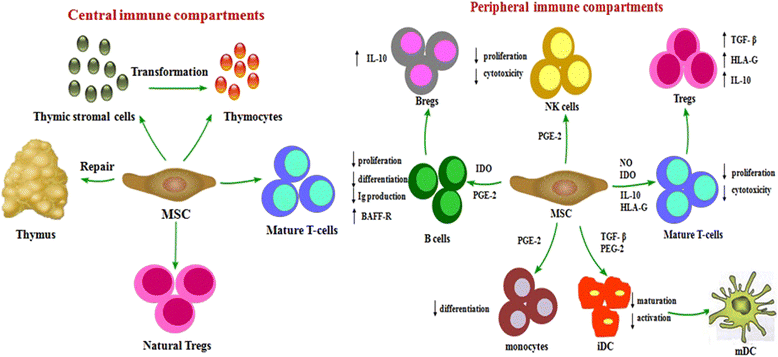The clinical application of mesenchymal stromal cells in hematopoietic stem cell transplantation
- PMID: 27193054
- PMCID: PMC4870746
- DOI: 10.1186/s13045-016-0276-z
The clinical application of mesenchymal stromal cells in hematopoietic stem cell transplantation
Abstract
Mesenchymal stromal cells (MSCs) are multipotent stem cells well known for repairing tissue, supporting hematopoiesis, and modulating immune and inflammation response. These outstanding properties make MSCs as an attractive candidate for cellular therapy in immune-based disorders, especially hematopoietic stem cell transplantation (HSCT). In this review, we outline the progress of MSCs in preventing and treating engraftment failure (EF), graft-versus-host disease (GVHD) following HSCT and critically discuss unsolved issues in clinical applications.
Keywords: Aplastic anemia; Engraftment failure; Graft-versus-host disease; Hematopoietic stem cell transplantation; Infection; Mesenchymal stromal cell; Relapse.
Figures

Similar articles
-
Mesenchymal Stromal Cells in Pediatric Hematopoietic Cell Transplantation a Review and a Pilot Study in Children Treated With Decidua Stromal Cells for Acute Graft-versus-Host Disease.Front Immunol. 2020 Oct 19;11:567210. doi: 10.3389/fimmu.2020.567210. eCollection 2020. Front Immunol. 2020. PMID: 33193339 Free PMC article.
-
The role of mesenchymal stem cells in hematopoietic stem cell transplantation: prevention and treatment of graft-versus-host disease.Stem Cell Res Ther. 2019 Jun 21;10(1):182. doi: 10.1186/s13287-019-1287-9. Stem Cell Res Ther. 2019. PMID: 31227011 Free PMC article. Review.
-
Long-Term Follow-Up After the Application of Mesenchymal Stromal Cells in Children and Adolescents with Steroid-Refractory Graft-Versus-Host Disease.Stem Cells Dev. 2021 Mar;30(5):234-246. doi: 10.1089/scd.2020.0191. Epub 2021 Feb 19. Stem Cells Dev. 2021. PMID: 33446053
-
Mesenchymal Stromal Cells in Hematopoietic Stem Cell Transplantation.Methods Mol Biol. 2016;1416:3-20. doi: 10.1007/978-1-4939-3584-0_1. Methods Mol Biol. 2016. PMID: 27236663
-
Mesenchymal Stem Cell Derived Extracellular Vesicles: A Role in Hematopoietic Transplantation?Int J Mol Sci. 2017 May 9;18(5):1022. doi: 10.3390/ijms18051022. Int J Mol Sci. 2017. PMID: 28486431 Free PMC article. Review.
Cited by
-
Immunological Basis of Bone Marrow Failure after Allogeneic Hematopoietic Stem Cell Transplantation.Front Immunol. 2016 Sep 16;7:362. doi: 10.3389/fimmu.2016.00362. eCollection 2016. Front Immunol. 2016. PMID: 27695456 Free PMC article. Review.
-
[The role of mesenchymal stem cells in allogeneic hematopoietic stem cell transplantation for patients with refractory severe aplastic anemia].Zhonghua Xue Ye Xue Za Zhi. 2019 Sep 14;40(9):726-731. doi: 10.3760/cma.j.issn.0253-2727.2019.09.003. Zhonghua Xue Ye Xue Za Zhi. 2019. PMID: 31648472 Free PMC article. Chinese.
-
hUC-EVs-ATO reduce the severity of acute GVHD by resetting inflammatory macrophages toward the M2 phenotype.J Hematol Oncol. 2022 Jul 21;15(1):99. doi: 10.1186/s13045-022-01315-2. J Hematol Oncol. 2022. PMID: 35864538 Free PMC article.
-
Extracellular Vesicles: A New Prospective in Crosstalk between Microenvironment and Stem Cells in Hematological Malignancies.Stem Cells Int. 2018 May 27;2018:9863194. doi: 10.1155/2018/9863194. eCollection 2018. Stem Cells Int. 2018. PMID: 29977309 Free PMC article. Review.
-
Combination of Haploidentical Hematopoietic Stem Cell Transplantation with Umbilical Cord-Derived Mesenchymal Stem Cells in Patients with Severe Aplastic Anemia: A Retrospective Controlled Study.Turk J Haematol. 2022 Jun 1;39(2):117-129. doi: 10.4274/tjh.galenos.2022.2022.0084. Epub 2022 Apr 22. Turk J Haematol. 2022. PMID: 35448935 Free PMC article.
References
Publication types
MeSH terms
LinkOut - more resources
Full Text Sources
Other Literature Sources

